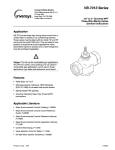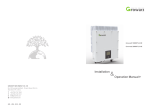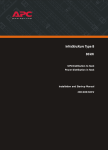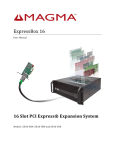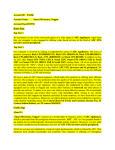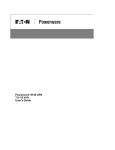Download APCs response to competitive claims:
Transcript
Invensys’ response to APCs response to competitive claims about the Powerware 9170 Invensys claim: APC replied: The intelligence in this product is built into the power modules. Invensys claims that this makes their product more redundant because the user can build more than N+1 redundancy into power, battery, and intelligence. While it is true that the user can place additional modules into a frame to create extra redundancy, they can only do this if they have not reached capacity of the frame or if they do not have run time requirements that require use of the extra slots. In addition, while this may seem like a good idea, looking at it in reality gives a different understanding. The issue is that the components in power modules (DC Capacitors, MOVs, etc-.) are the most likely to fail in the first five years (Symmetra Power Modules make up 95% of all APC RMA). The components in the intelligence are the least likely to fail. Combining the two actually reduces the reliability of the system intelligence. The biggest reason this is an issue is that the intelligence drives the automatic internal bypass of the UPS. A failure of a module in a nonredundant system (or multiple modules in a redundant system) could result in down time. Invensys responded: APC is very good at pulling you off point. At issue here is the fact, the Powerware 9170 is inherently more reliable because of its design features: The Powerware 9170 utilizes Industry leading Control Area Network (CAN) communication, which is the norm in the automotive and other large manufacturing industries We have also designed redundancy into the power and logic controls of each power module APC claims we decrease reliability by housing all components in the power module. Actually this design philosophy virtually eliminates any single-point-of-failure because by simply increasing the number of power modules in an enclosure we can achieve N+1, N+2, up to N+X redundancy o With APC’s two redundant intelligence cards they can only offer N+1 power and logic redundancy Each power module has its own internal bypass so if a power module should fail it has it’s own internal bypass rated at 2X the module rating (6kVA) It is very easy to size an enclosure to allow for additional modules for either N+X redundancy or additional runtime, utilizing our configurator It is very easy to add extended battery cabinets for additional runtimes Additionally, APCs Power Modules are intelligent having built in microprocessor control. However, APC has over-all system control modules (MIM and RIM) whose design objective is to provide the highest availability possible. Symmetra users can also add additional power and battery modules to be greater than N+1 redundant providing the loads allow it. This ensures greater levels of redundancy where it is needed- in the most likely components to fail (power and battery). Invensys claims that since their battery packs are less than 30 pounds that their system is more user serviceable than Symmetra. They have designed their battery modules so that two 60V-battery modules fit into a slot in series to provide a 120V battery system. It is true that the battery packs are light and that this makes it easy for one person to swap one. This however does not mean their overall system is 'more user serviceable'. In fact, a closer look at the rest of the Invensys design reveals some things that make it much more difficult for a user to service this product Here is a list of some of these things: The combination of all of these features makes the Powerware 9170 significantly more reliable than the Symmetra. User serviceability is a key selling point of the PW9170, and numerous design features were incorporated to achieve this. First and foremost, the power and battery modules may be quickly swapped in and out of the system without affecting system operation or performance. But let’s look at APC’s claims one at a time: 1. 1. 2. 3. March 26, 2001 The split battery packs cannot be monitored individually in the UPS frame; rather they are monitored as a string. This means customers will have to replace both battery modules in the event of a single module failure. There is no external cabinet intelligence meaning the customer cannot diagnose bad batteries in these cabinets, cannot tell what their actual runtime is, and cannot actually find a bad module to swap. The LCD display is not user replaceable, to swap this display requires someone to remove the top of the unit exposing them to the DC bus in 2. COMPANY CONFIDENTIAL Contrary to APC’s claim, a user will NOT have to swap both battery modules in response to a battery alarm by simply switching the modules into another slot and re-running the battery test the unit can isolate the individual battery module that needs replacement. The Powerware 9170 DOES, in fact, calculate runtime for the entire battery system without the cost of additional intelligence in the external battery cabinet. During start-up the PW9170 queries how many external ampere-hours are connected to the UPS. The Page 1 4. 5. 6. 7. the frame. The bypass design discussed earlier means they cannot swap a Power Module in a non- redundant frame without dropping the load. The customer has to know they need to use the external bypass. It there is no external bypass they will have to know to remove battery modules from one slot place the new power module in that slot remove the failed power module and then install the battery modules in this slot. This leaves lots of opportunities to inadvertently drop the load. Extended run times cannot be "hot-installed' once the UPS is on. Installing the cable connecting the cabinets requires direct access to the DC bus meaning all power has to be off to the UPS. It will also require an electrician to install. When installing or removing modules, the Invensys UPS does not tell the user anything. This leaves the user with no certainty that the module has made connection and is working. The overall diagnostic and control features of the Invensys UPS are clumsy and incomplete. These make it very difficult for an end-user to set up the system and it is almost impossible to do anything without the manual and some technical support. 3. 4. 5. 6. 7. March 26, 2001 COMPANY CONFIDENTIAL PW9170 utilizes this information to easily calculate the system runtime. In the case of a battery alarm, additional steps as noted above can be taken to determine the exact battery module for replacement. The LCD is not a high failure item, and the likelihood of this failing is nearly zero. It does require qualified service personnel to remove the top cover for service. If the LCD fails, the UPS will continue to function normally without affecting the critical load. This claim is completely untrue. It appears APC did not understand the difference between an internal and an external bypass switch. The Powerware 9170 features full redundancy when two or more power modules are utilized. Each 3kVA power module incorporates an internal 6kVA static bypass switch, which assures that critical loads are never dropped in the unlikely event of a power module failure. If a power module fails, power is automatically routed through the remaining power module(s) in the system. The LCD clearly indicates to the user which power module requires replacement. The module can then be quickly swapped with a replacement module. No complex swapping of slots is required, as APC claims. This has nothing to do with serviceability, but we chose this method because we did not want to expose the end user to the 120Vdc which is present in a “hot installed” connection method. If a customer does need to add additional extended battery runtimes after the initial installation it probably means that conditions have changed. And typically will want to schedule this during a downtime. It will take a qualified person to add the additional cabinet but servicing the system after installation is just as simple as ever. Again, the claim is completely invalid. The number of active power and battery modules is shown on the top of the screen and is updated when a module is added or removed. All other critical information (alarms, etc.) will be displayed when a problem arises. The configuration screen contains all the basic set up information and is accessible at any time from the idle screen. Any more advanced configuration and diagnostic information of any UPS would require qualified technical support for a typical end user. Page 2 Customers can run the Powerware 9170 in a special PowerSave mode, which allows the user to get up to 98% efficiency. They do this by placing the UPS into bypass and then coming off bypass to go to battery when needed. Placing the UPS in bypass and relying on everything to work when switching out of bypass is risky. If high efficiency is more important to the customer than high availability then they should look at other UPS topologies (like APC’s Silcon UPS or Smart-UPS) that deliver high efficiency without risking the loads. Symmetra has an 87% efficiency rating for the 208V product and a 91 % efficiency rating for the 230V product. Invensys' design includes four UPS frames of different size that can be used anywhere in the world. There are different Power Modules for different voltages and universal battery modules. There are also three different size extended battery cabinets. Two of the UPS frames can be placed in a rack (with the purchase of mounting rails) or on the floor. 3kVA power modules give the customer the flexibility to create 3, 6 or 9kVA rackmount and 3 18kVA tower UPS solutions. This makes the 9170 the most flexible UPS in the world. Invensys has removed all intelligence from the frame and incorporated it into the power modules. APC has intelligence built into the frame creating a March 26, 2001 Invensys uses universal frames and different voltage modules to build systems around the world. APC uses universal modules and different voltage frames to build systems around the world. The advantage of using different voltage frames Is that there Is no chance of wiring in a frame and using an incorrect module that does not output the proper voltage and could damage the loads. Also, the universal frame Invensys uses make it more difficult for an electrician to wire the product correctly. The users manual has twelve different installation diagrams and several different tables to review in order to correctly install the product. The Powerware 9170 utilizes a universal frame in different size ratings (3-, 6-, 9-, 12-slot), and two power models and one battery module that may be installed in any of the enclosures slots. This allows anyone to install or swap-out a module without affecting system operation or performance. It also makes stocking for our resellers, distributors and OEMs much easier to manage. The unit is shipped with a comprehensive Users Guide, providing instructions for installation of the system worldwide. To date we have had no complaints about the complexity of the manual. Symmetra frames are essentially the same worldwide. The only differences are that the 230V frame has no output isolation transformer and the terminal blocks are configured to make it easier for local electricians in different regions to install. In addition, our unique split-phase power modules allow us to offer a 3-wire output without needing to have an expensive internal isolation/step-down transformer installed in the chassis. PowerSave mode is a user-selectable mode. The system does operate in bypass during this mode but only if the input voltage is within safe and acceptable tolerances (user-defined). If the input voltage falls out of range for any reason, the UPS transfers back to normal double conversion online operation. Even during normal operation, the Powerware 9170, a double conversion online UPS system, provides 88% efficiency at full load. This option may not be right for all applications, but with the current state of energy costs and situations like the crisis in California the PowerSave mode can be a valuable “optional” mode of operation for our customers. APC has a Rack-mount offering in the 2-16 kVA range, while Invensys does not. Also, Invensys Rack-mount offering is simply their 6-slot tower cabinet with some rails ordered separately. This solution is size optimized to be a tower, not a rack as the Invensys solution for 6kVA N+1l is 22 Rack Units (U) high. Compare that to a Symmetra 6 kVA rack-mount N+1 at 8U and a 12kVA N+1 rack-optimized solution from APC that takes just 15U of rack space. APC provides double power than Invensys in the same rack space! The Powerware 9170 is a configurable UPS and can be ordered to meet any customer requirements. In addition, we have recently released new complete Powerware 9170 UPS systems with bundled part numbers to satisfy those who require pre-configured systems. The Powerware 9170’s design is optimized on 4-enclosures, 2-power modules and 1-battery module for all global requirements! This design yields 3 – 18KVA, N+X redundancy and tower/rackmounting capabilities. No special rackmounting enclosures and modules are required. This also leads to reduced inventories (SKUs) and lower prices to the customer. The Powerware 9170 utilizes Control Area Network (CAN) Invensys has removed some of the components from the frame that can be communications. The automotive industry migrated from IIC to CAN found in the Symmetra frame. Their claims are not true however. APCs years ago due to its superior reliability and fault tolerance in hostile intelligence is built into the redundant intelligence modules that are installed in the frame before delivery, but can be easily hot-swapped by the user in the environments. event of a failure. The only part of the intelligence that is in the Symmetra It is incorrect to state that a faulted node on the CAN bus will take the frame is the IIC communication bus. This is found in the back plane of the UPS system down. Failure of the active circuitry in the frame during Symmetra in the form of traces contained within circuit boards. COMPANY CONFIDENTIAL Page 3 the frame creating a single point of failure and allowing cascading failure of power modules. Invensys has engineered a modular UPS system with some revolutionary new technology cutting a lot of the cost out of modular design. This enables lnvensys to give customers redundant power protection for the price of non-redundant. Symmetra in the form of traces contained within circuit boards. These are required to connect the modules to the intelligence. IIC is a very well known, highly reliable communications protocol and requires no active components (integrated circuits with low MTBF) within the frame itself. Inspection of the Powerware 9170 frame reveals some integrated circuits exposed in the frame. Additionally, the Symmetra power modules do disconnect from this bus when they fail, virtually eliminating cascading failure. Invensys is claiming that it is revolutionary technology that is cutting the cost of the modular design. The truth is that the cost of the system has been cut through sacrificing component quality, system robustness, and by leaving out important system features. 1. Use of CAN technology actually increases overall system MTBF because of the increased reliability of the communications. The Powerware 9170 is designed as a highly engineered, scalable, modular, flexible UPS that combines the highest level of reliability with the lowest cost of ownership in the 3 –18 kVA range! Reviewing the examples sited: Examples of component quality are that they have used the bare minimum sized bypass and charging components. The bypass relays that drive the internal bypass are sized only big enough to support the load when redundancy is present. If the system is in bypass and the user tries to remove a non-redundant power module, they will experience a load drop (see page 24 of Powerware 9170 user manual). The chargers in each module are 140W chargers (compared to Symmetra's 350w). This means that a customer must purchase an external battery charger for runtime requirements over 1 hour. These are third party battery chargers that are large, clunky, and cost $2500. System robustness is evident in the flimsy frame design of the product. The Sheet Metal is barely strong enough to support the modules. The battery modules actually bend the shelves to the point where after some time; they can be pulled from the System completely bypassing the safety stops that prevent user injury. Finally, Invensys has left it up to the customer to choose the correct components to build a complete high availability system. The Powerware 9170 has no external bypass built in and it is recommended that an external maintenance bypass be purchased. It also does not have galvanic isolation built in- it also must be purchased separately. There is no intelligence in the extended run cabinets so a customer will be forced to purchase preventative maintenance (it is recommended on page 23 of the user manual to do this every 6 months). All these extras will cost the customer as much as $8000 over the initial system cost. 1. It is important to note that when APC designed the Symmetra Power Array there was no other N+1 Modular power protection system on the market. APC had to deliver a product that met customer expectations and was not influenced by other product on the market. Invensys has done some things that make it easy to market against the Symmetra but when examined actually can sacrifice system reliability. This is a result of having to deliver a system 7. 2. 3. 4. 5. 6. 7. March 26, 2001 operation will not jeopardize the customer’s critical load. Like the Symmetra, if the Powerware 9170 has a failure in the power module the power module disconnects itself from the bus. 2. 3. 4. 5. 6. COMPANY CONFIDENTIAL Every power module has its own internal bypass that is rated at 6kVA, (twice the power module rating) and will support the critical load in the event of a failure, with a minimum of two power modules used in the system. The Powerware 9170s charger will sufficiently keep the batteries charged and recharge them after a discharge. We will be releasing an optional 20amp hot-swappable charger (in April/May) that can be inserted into any available slot of the UPS chassis or a new 12 slot extended battery cabinet which will support up to three chargers (60amps) for additional charging needs. The Powerware 9170 has passed all applicable safety, agency and shipping tests. Because the power and battery modules are so much lighter than the APC modules we are able to reduce chassis cost because we don’t have to support the same amount of weight. The simplicity of the Powerware 9170 is evident here, because you can order pre-configured solutions or add value to your customer by custom configuring the solution they need. In addition, we now offer bundled part numbers for complete Powerware 9170 solutions. As with all power products if the system needs any type of internal service it is good safety practice to completely remove power from the device you are working on, thus an external maintenance bypass is recommended. Galvanic isolation is currently an available option for the Powerware 9170. It is recommended by all UPS manufactures that periodic maintenance inspections be performed. We recommend, but do not require, annual preventive maintenance inspections, with biannual being the optimal approach. In this 24/7 world this proactive approach helps identify potential problems before there is a problem. Powerware offers a variety of service options (none Page 4 designed to defend eroding market share rather than to be the best solution possible for customers. costing as much as stated by APC) and all work performed by factory trained company personnel. It is important to remember whom the industry leader in patents and innovative technology applications are – Powerware! We have sacrificed nothing but are providing a better technological, lower cost solution to this critical market. March 26, 2001 COMPANY CONFIDENTIAL Page 5






